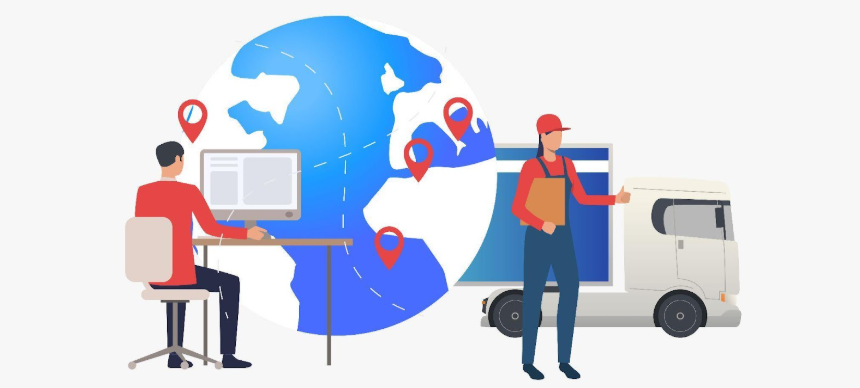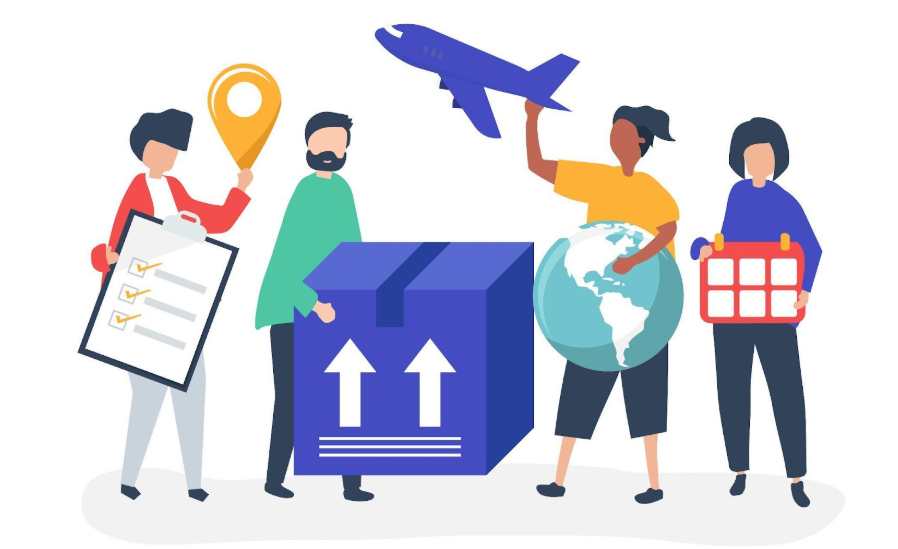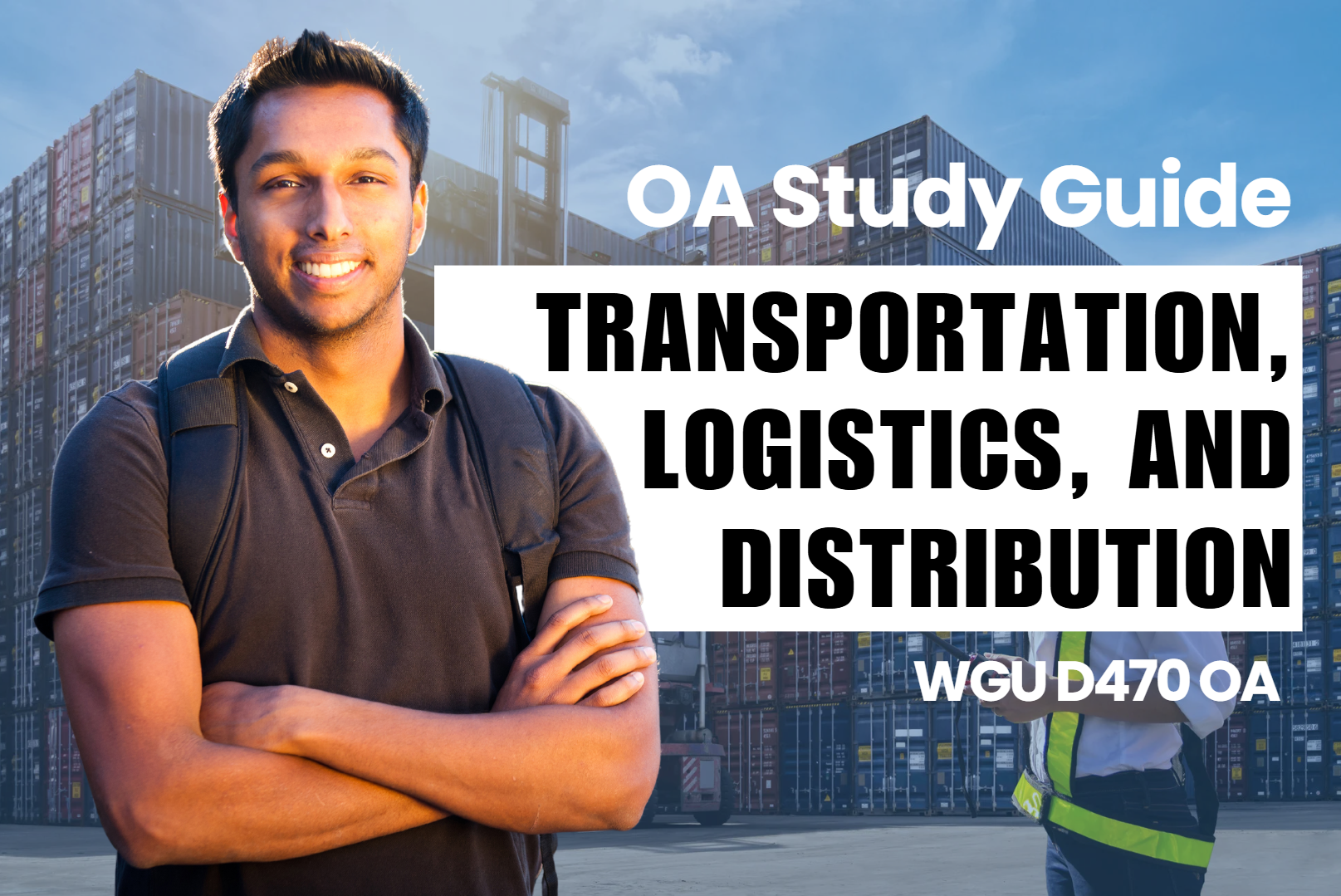WGU D470 OA Study Guide - 2025 | Mastering Logistics📖
Customers who place their desired gadget order face the struggle of awaiting its delivery forever or discovering it went missing altogether in the shipping process. Sounds like a nightmare, right? Every thriving business depends on logistics operations to execute its successful operations. The operation of logistics stands as a vital element in maintaining both the on-time delivery of goods to customers and order in warehouse management standards.
This article explores key concepts related to logistics, strategic decision-making, and outsourcing:
- Definition of LOGISTICS: Logistics refers to the management of the flow of goods, services, and information across the supply chain, ensuring that products are delivered to the right place, at the right time, and in the right condition.
- Differences between Strategy, Tactics, Operations: Strategy outlines the long-term goals and direction of a business, tactics define the actions and plans to achieve these goals, and operations focus on the day-to-day activities that support the business’s functioning.
- Direct vs Multiuser Outsourcing: Direct outsourcing involves a single provider handling all of a company’s logistics needs, while multiuser outsourcing involves multiple providers sharing responsibilities, potentially reducing costs and increasing flexibility.
- External vs Internal Factors: Internal factors are controllable elements within a company, such as resources and capabilities, while external factors include market conditions, competitors, and regulations, which are beyond a company’s control but influence decision-making.
By the time you’re done reading, you’ll have a firm grasp of logistics fundamentals, helping you navigate WGU D470 OA concepts with confidence. Let’s get started!
How to Use This Guide for the WGU D470 OA Exam?📖
The D470 Transportation, Logistics, and Distribution OA exam at WGU evaluates your understanding of logistics management, supply chain strategies, and outsourcing decisions. This guide simplifies the key concepts of the definition of logistics, the differences between strategy, tactics, and operations, direct vs multiuser outsourcing, and external vs internal factors to help you grasp the topics tested in the exam.
We also provide exam-style questions and practical applications to ensure you’re fully prepared for the questions on the WGU D470 OA exam.

Understanding Logistics For D470 OA: The Backbone of Efficient Supply Chains📝
Online customers often wonder how their purchase travels before reaching their front door. A sophisticated network handles your package distribution through warehouses to delivery vehicles and then finally to your address. The term logistics defines the system that maintains significance throughout supply chains. The efficient delivery of customer products becomes impossible for businesses when they lack logistics capabilities. We will analyze the precise definition of logistics first while discussing its fundamental elements followed by an evaluation of its essential value and its historical development.
What is Logistics?
The effective planning execution and management of goods movement until they reach their consumers defines logistics. The framework enables businesses to deliver the correct products directly to consumer destinations at appropriate moments. Back-office operations within retail businesses heavily rely on logistics management systems which represent a part of the complete supply chain structure.
Think about a supermarket. Logistics ensures that materials for food production reach manufacturers, products are stocked in warehouses, stores have enough inventory to meet customer demand, and returned items are processed smoothly. Without logistics, businesses would struggle to keep up with demand.
Key Components of Logistics
- Movement of Goods: Logistics is fundamentally about transporting goods from one location to another. This includes shipping, warehousing, and distribution. The main goal is to ensure that goods arrive safely and on time.
- Resource Management: It involves managing people, materials, and products from their origin to their final destination. This includes how resources are acquired, stored, and transported.
- Supply Chain Integration: Logistics is part of the overall supply chain, which is a network of businesses working together to produce and distribute goods efficiently.
- Customer Satisfaction: Logistics systems achieve customer satisfaction by providing them with necessary products at their required delivery time. The performance of a well-operating logistics system speeds up delivery while avoiding product shortages which leads to satisfied customers.
- Reverse Logistics: A reverse logistics approach must also be handled by logistics operations because it deals with efficiently returning merchandise to vendors.
Historical Background of Logistics
Since its military origin logistics has undergone development into its current form. During its historical origins, the term existed to describe the movement of military personnel together with their equipment and supplies. Since its expansion into the business world logistics has proved essential for manufacturing businesses to effectively handle supply chain resource management. Commercial expansion through e-commerce makes logistics centrally important because it guarantees worldwide product deliveries to customers.
Components of a Logistics System
- Transportation: The transport of products happens through vehicles which include vehicles aircraft and ships.
- Warehousing: The storage location for products exists in warehouses until they become necessary for use.
- Distribution: Goods move from warehouses to retailers or directly to customers.
- Inventory Management: Internal controls of stock inventory help maintain proper product amounts to prevent breakdowns while avoiding product surplus.
Why is Logistics Important?
- Efficiency: Logistics helps products move smoothly through the supply chain, reducing delays.
- Cost Reduction: Good logistics management helps reduce costs associated with transportation and storage.
- Customer Satisfaction: Quick and dependable delivery services provide customers with superior satisfaction.
- Avoiding Stock Shortages: Appropriate logistics management prevents the disruption of stock availability by maintaining suitable inventory amounts throughout all business operations.
- Competitive Advantage: Efficient logistics systems operated by companies provide better delivery speed than competing businesses can achieve.
Logistics vs. Operations Management
Operations management handles product transformation from raw materials to final products yet logistics concentrates on the distribution of goods from source to destination. The integration of logistics into operations strategy allows businesses to achieve better efficiency but the two functions stay distinct unless consolidated.
Efficient decision-making and sustained business success demand businesses recognize the separate functions of strategy tactics and operations for informed choices. Understanding this topic will greatly help with the success of WGU D470 OA.
Understanding the Differences Between Strategy, Tactics, and Operations in Logistics For D470 OA📝
In the world of transportation, logistics, and distribution, businesses need a structured plan to ensure smooth operations. But how do companies decide what needs to be done, how to do it, and when to execute it? That’s where strategy, tactics, and operations come in. Understanding the differences between these three concepts is essential for optimizing logistics and supply chain management. In this section, we will break down these terms in a simple, clear way to help you see how they fit together.
What is Strategy?
Strategy is the big-picture plan. It focuses on long-term goals and shapes the overall direction of a company’s logistics and supply chain operations. Companies develop logistics strategies to ensure efficiency, cost-effectiveness, and competitive advantage in the market.
Key Features of Strategy:
- Time Frame: Long-term (several years)
- Scope: Broad, covering the entire supply chain
- Focus: High-level decisions, such as selecting distribution center locations, choosing transportation modes, and implementing new technology
- Examples:
- Deciding whether to use third-party logistics (3PL) providers
- Choosing between regional and centralized distribution centers
- Implementing automation for warehouse operations
What are Tactics?
Tactics refer to the mid-level decisions that help implement the company’s strategy. If strategy is the blueprint, tactics are the step-by-step instructions to bring that plan to life. Tactics bridge the gap between strategy and daily operations.
Key Features of Tactics:
- Time Frame: Mid-term (6 months to 2 years)
- Scope: More specific than strategy, focusing on how to achieve strategic goals
- Focus: Material flow management, inventory control, production scheduling
- Examples:
- Determining inventory levels for different products
- Planning efficient delivery routes for regional distribution
- Scheduling warehouse staff to optimize productivity
What are Operations?
Operations are the day-to-day actions that put strategy and tactics into motion. They involve real-time decision-making and adjustments to ensure smooth logistics performance.
Key Features of Operations:
- Time Frame: Short-term (daily or weekly activities)
- Scope: Narrow, dealing with specific tasks
- Focus: Execution of tactical plans, ensuring timely deliveries and efficiency in warehouse management
- Examples:
- Managing daily transportation schedules
- Overseeing warehouse order fulfillment
- Adjusting delivery routes due to unexpected delays
How Strategy, Tactics, and Operations Work Together
While each concept serves a different purpose, they are all interconnected. A strong strategy provides a stable foundation, tactics break it down into actionable steps, and operations execute those steps daily.
Example in a Logistics Setting:
Imagine a company wants to expand its e-commerce distribution network:
- Strategy: The company has decided to open two new distribution centers to reduce delivery times.
- Tactics: Managers plan the best locations for the new centers, calculate optimal inventory levels, and determine the most cost-effective shipping routes.
- Operations: Warehouse staff process and ship orders daily, delivery drivers follow optimized routes, and logistics teams monitor performance to make real-time adjustments.
The Role of Technology in Logistics Planning
Advancements in technology play a crucial role in integrating strategy, tactics, and operations. Companies use tools such as:
- Warehouse Management Systems (WMS) to streamline inventory tracking
- Transportation Management Systems (TMS) for route optimization
- Real-time tracking and GPS systems to monitor shipments
When businesses seek to optimize their logistics operations, they must decide between direct outsourcing for personalized control or multiuser outsourcing for shared efficiency—each with its own advantages and trade-offs. Thoroughly go through these concepts before taking the WGU D470 OA for the best results.
Tired of reading blog articles?
Let’s Watch Our Free WGU D470 Practice Questions Video Below!

Direct vs. Multi-User Outsourcing in Logistics For D470 OA📖
Companies select outsourcing as their supply chain operation optimization strategy by working with third-party logistics providers (3PLs) for collection warehousing and distribution functions. All outsourcing approaches provide different specifications within supply chain management. Companies select between direct outsourcing or multi-user outsourcing which offers different benefits and drawbacks for their operations. The comparison between these approaches enables businesses to make decisions regarding their preferred outsourcing model.
What is Direct Outsourcing?
A company that exclusively uses 3PL provider services for maintaining its operations practices direct outsourcing or dedicated contract carriage. Exclusive resources including warehouses along with transportation services and staff belong solely to the company’s needs.
Key Characteristics of Direct Outsourcing:
- Dedicated Resources: The 3PL provider assigns specific facilities, trucks, and employees to a single company.
- Customization: Services are tailored to meet the company’s unique logistics needs.
- Long-Term Partnerships: Businesses often establish ongoing agreements with the 3PL provider.
- Higher Control: Companies have greater influence over operations while still outsourcing execution.
Benefits of Direct Outsourcing:
- Tailored Solutions: Services are specifically designed for a company’s supply chain.
- Predictable Costs: Since resources are dedicated, expenses remain relatively stable.
- Higher Service Quality: Dedicated resources ensure efficiency and reliability.
What is Multi-User Outsourcing?
Multi-user outsourcing involves sharing 3PL resources with multiple companies. Instead of having dedicated facilities or personnel, businesses share the same infrastructure, allowing for cost savings and flexibility.
Key Characteristics of Multi-User Outsourcing:
- Shared Resources: Warehouses, transportation, and labor are used by multiple clients.
- Standardized Services: Processes are generally uniform across all users.
- Lower Costs: Expenses are distributed among multiple companies, making them more affordable.
- Less Control: Since resources are shared, businesses have less direct oversight.
Benefits of Multi-User Outsourcing:
- Cost Savings: The sharing of infrastructure expenses together with operational costs leads to reduced business expenditures.
- Flexibility: Operating levels can change easily thanks to business demand fluctuations.
- Wider Network Access: 3PL providers manage different clients while providing their customers extended access to their broad supply chain networks.
Key Differences Between Direct and Multi-User Outsourcing
Feature | Direct Outsourcing | Multi-User Outsourcing |
Resources | Dedicated to one client | Shared among multiple clients |
Customization | Highly customized | Standardized services |
Cost | Higher, but predictable | Lower, as costs are shared |
Control | High | Lower |
Flexibility | Less flexible | More scalable and adaptable |
Partnership | Close, long-term | More transactional |
Choosing the Right Outsourcing Model
Companies should consider the following factors when choosing between direct and multi-user outsourcing:
- Cost Efficiency: If reducing logistics costs is a priority, multi-user outsourcing may be a better fit.
- Service Quality: Businesses that require personalized, high-quality service should opt for direct outsourcing.
- Scalability Needs: If demand fluctuates often, multi-user outsourcing provides more flexibility.
- Operational Control: Companies that need strict oversight and control may benefit from direct outsourcing.
How Technology Enhances Outsourcing Models
Both outsourcing models leverage technology for efficiency:
- Warehouse Management Systems (WMS): Helps businesses track inventory in real-time.
- Transportation Management Systems (TMS): Optimizes delivery routes and schedules.
- GPS and RFID Tracking: Provides visibility into shipments and logistics operations.
Every successful logistical operation depends on various internal and external forces to make decisions and fulfill efficiency standards while delivering supply chain performance excellence.

Internal vs. External Factors in Logistics For D470 OA📝
A logistics strategy needs both internal operational elements and external elements that determine operational success decision-making effectiveness and operational efficiency. Businesses achieve supply chain optimization by recognizing these factors which enable product movement from suppliers to their target customers. The following section will analyze the main internal and external factors that shape logistics performance and affect a business’s success outcomes.
Internal Factors Affecting Logistics
Internal factors are elements within a company’s control, shaping how logistics operations are managed. These factors influence efficiency, cost management, and supply chain execution.
1. Company Culture and Values
- The culture of a company influences decision-making in logistics.
- A strong logistics-oriented culture ensures smooth coordination between departments.
2. Organizational Structure and Resources
- The structure of a company dictates how logistics operations are managed.
- The availability of resources like manpower, capital, and technology affects efficiency.
3. Business Objectives and Goals
- A company’s strategic goals determine logistics priorities.
- These goals may include reducing costs, improving service levels, or expanding into new markets.
4. IT Infrastructure and Technology
- Advanced technology enhances logistics efficiency through automation, tracking, and data analysis.
- Information systems support supply chain integration and improve decision-making.
External Factors Affecting Logistics
External factors are outside a company’s control but play a crucial role in shaping logistics operations. These factors include market conditions, government policies, and technological advancements.
1. Market Trends and Customer Demands
- Changing customer expectations impact delivery speed, inventory management, and distribution networks.
- Companies must adapt to shifting market trends to remain competitive.
2. Competition
- The presence of competitors drives innovation in logistics strategies.
- Businesses must optimize supply chain efficiency to gain a competitive edge.
3. Economic and Political Conditions
- Factors like exchange rates, inflation, and tariffs influence logistics costs.
- Political stability and trade regulations can impact supply chain decisions.
4. Environmental and Regulatory Issues
- Companies must comply with environmental policies and logistics regulations.
- Regulations regarding transportation, emissions, and packaging affect logistics planning.
5. Technological Advancements
- New technologies like AI, blockchain, and IoT improve logistics efficiency.
- Companies must invest in technology to streamline operations and enhance tracking capabilities.
6. Transportation and Infrastructure Development
- Well-developed infrastructure ensures faster and more cost-effective deliveries.
- Poor infrastructure can lead to delays and increased transportation costs.
Balancing Internal and External Factors
To develop an effective logistics strategy, companies must integrate both internal and external factors:
- Internal Integration: Coordination between departments ensures seamless logistics execution.
- External Collaboration: Working with suppliers, 3PL providers, and regulators helps adapt to external challenges.
- Flexibility: Businesses must remain adaptable to respond to changing market conditions.
These concepts will be tested heavily on the WGU D470 OA questions.

Final Thoughts: Mastering Logistics for WGU D470 OA Success📖
Congratulations! You have studied fundamental logistics concepts that include the definition followed by tactical-operational variations, single-user-and-multi-user outsourcing principles and internal-external influences on logistics strategies. All these fundamentals remain essential for aligning with supply chain management principles and they directly appear in the WGU D470 OA final assessment tests.
Master key logistics principles since they provide an essential base for actual applications throughout supply chain operations in transportation distribution systems. Access the material again while applying knowledge to practical situations and perform critical problem-solving for logistics executive choices.
Remember, logistics isn’t just about moving goods—it’s about strategy, efficiency, and making businesses thrive. Wishing you the best of luck in your final OA for WGU D470! You’ve got this!






